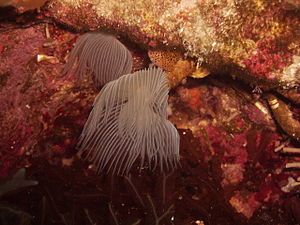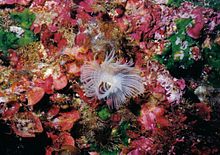Smooth calcareous tube worm
| Smooth calcareous tube worm | ||||||||||||
|---|---|---|---|---|---|---|---|---|---|---|---|---|

Smooth tube worm ( Protula tubularia ) |
||||||||||||
| Systematics | ||||||||||||
|
||||||||||||
| Scientific name | ||||||||||||
| Protula tubularia | ||||||||||||
| Montagu , 1803 |
The smooth lime tube worm ( Protula tubularia ) is a species from the family of lime tube worms that occurs in the Mediterranean , Atlantic and North Sea .
distribution
The species is native to the entire Mediterranean . Protula tubularia is found in the East Atlantic and the Northwest Atlantic. The distribution area extends in Europe to the Irish and British coasts. Evidence is also available from the Gulf of Maine , New Zealand and South Africa .
habitat
The species is found on rocky soils, stones and other hard substrates. Protula tubularia is particularly common on scree fields and the rocky coast of the upper sublittoral .
behavior
The smooth lime tube worm builds white lime tubes with a circular cross-section, which it cementes along the length of the respective adhesive substrate (rock, etc.). The mouth of the tube protrudes slightly into the open water. The worm never leaves its tube. It feeds itself by filtering microorganisms that it catches with the help of its tentacle crown. The tentacle crown is formed by two tentacle bearers attached to the worm's head. The tentacle carriers thus represent a fine-meshed catching device.
biology
The tube can reach a length of 15 cm and a diameter of 1 cm. The tentacle wreath measures a maximum diameter of 3 cm. The tentacle crown consists of two halves of the same shape, which are funnel-shaped or arranged in a slightly spiral manner. The calcareous tube is very solid and less mobile than that of the related Sabellidae . The coloring of the tentacle crowns is variable and ranges from white, orange to red.
Aquaristics
Despite the optimal size for aquariums, the species is extremely rarely seen in saltwater aquariums. Like all inhabitants of the Mediterranean Sea, this species also has special requirements in terms of temperature and living conditions that do not conform to normal marine aquariums . However, the smooth tube worm can often be seen in large zoological aquariums.
Synonyms
- Protula (Protula) tubularia (Montagu, 1803)
- Protula (Protula) tuburalia (Montagu, 1803)
- Protula (Psygmobranchus) protensa non Gmelin, Philippi, 1844
- Protula (Psygmobranchus) tubularia (Montagu, 1803)
- Protula borealis M. Sars, 1866
- Protula capensis McIntosh, 1885
- Protula elegans Milne Edwards, 1845
- Protula meilhaci Soulier, 1908
- Protula protensa non (Gmelin, 1791), sensu Philippi, 1844
- Protula rudolphi Risso, 1826
- Protula tabularia (Montagu, 1803)
- Protula tubularia capensis McIntosh, 1885
- Protula tubularia tubularia (Montagu, 1803)
- Psygmobranchus elegans (Milne Edwards, 1845)
- Psygmobranchus intermedius Marion, 1875
- Psygmobranchus pratensis (Gmelin, 1791)
- Psygmobranchus protensus non Gmelin, sensu Philippi, 1844
- Psygmobranchus simplex Quatrefages, 1866
- Psygmobranchus tubularis (Montagu, 1803)
- Serpula arundo Turton, 1819
- Serpula tubularia Montagu, 1803
literature
- What lives in the Mediterranean ?, Berbauer Humberg, Franckh-Kosmos Verlags-GmbH & Co.KG Stuttgart, 2009
- Fascinating underwater world of the Mediterranean, Claus Valentin, 1986
- Sea Fishes an Invertebrates of the Maltese Islands and the Mediterranean Sea, Lawson Wood, 2002
- The Dive Sites of Malta, Comino and Gozo, Lawson Wood, 1999
Web links
- WoRMS - World Register of Marine Species - Protula tubularia (Montagu, 1803) (Engl.)
- MarLIN - The Marine Life Information Network
- Marine Species Identification Portal: Protula tubularia (Eng.)
- WoRMS - World Register of Marine Species - Protula tubularia tubularia (Montagu, 1803) (Engl.)
Individual evidence
- ↑ WoRMS - World Register of Marine Species , accessed on March 31, 2012
- ^ Fascinating underwater world of the Mediterranean, Claus Valentin, 1986, p. 94
- ↑ What lives in the Mediterranean ?, Bergauer Humberg, Franckh-Kosmos Verlags GmbH & Co.KG Stuttgart, 2009, page 142
- ^ Sea Fishes and Invertebrates of the Maltese Islands and the mediterranean Sea, Lawson Wood, 2002, p. 56
- ↑ What lives in the Mediterranean ?, Bergauer Humberg, Franckh-Kosmos Verlags GmbH & Co.KG Stuttgart, 2009, page 142


